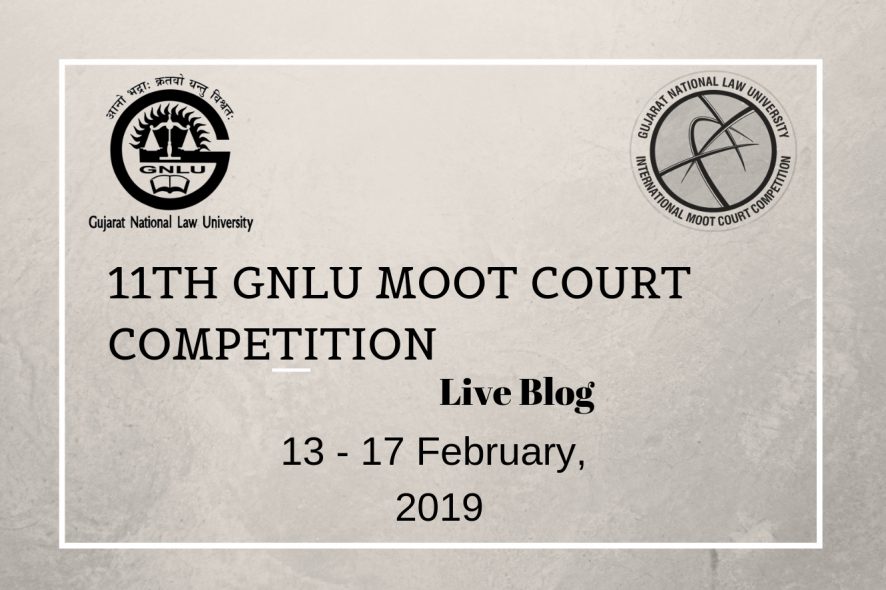The decade old moot is back for its eleventh edition! GIMC has always been known for its high quality participation as well as judging and this year, the moot is breaking all records. 56 teams have gathered from all around the world to battle for the prizes and to finally put all their preparation to the test. GIMC is the only Trade Law Moot in India which simulates a WTO dispute redressal mechanism and this has consistently attracted a number of bright legal minds.
The moot problem this year was drafted by Mr. Sagnik Sinha, and deals with intriguing issues on the WTO Agreement on Subsidies and Countervailing Measures. Up for grabs are the prizes of Winning Team, Runners-Up, Best Orator (Finals), Best Orator (Prelims), Best Researcher, Best Written Submissions, Second Best Orator (Prelims), Second Best Researcher, and Second Best Written Submissions.
The entire moot is conducted by the students of GNLU, with an Organising Committee of more than 100 members, along with assistance from their faculty Conveners and the support of the Director, Professor Dr. Bimal N. Patel. Additionally, Lakshmikumaran & Sridharan Attorneys, World Trade Institute, Bern, Centre for Trade and Investment Law- Indian Institute of Foreign Trade, Centre for WTO Studies, Lex Witness, Eastern Book Company and SCCOnline are the official partners of GNLU in organising this event.
The moot is soon to begin and we are here to keep you updated on exactly what is going on! You can also follow us on Twitter, Instagram and Facebook for more insights.
Registration and Inauguration Ceremony
1650 hours– The registration process has begun and the participants are being given their folders, schedules and of course, the delicious pastries!!
1655 hours– One can see the excitement and enthusiasm on the participants’ faces as they engage in friendly chit-chat amongst themselves and eat the pastries. They seem to be really enjoying it!!!
1720 hours- Let us have a look at what has brought the participants here today in the first place. All of them are vying for these beautiful trophies to take back home. Five days of intense competition for these beauties, totally worth it.
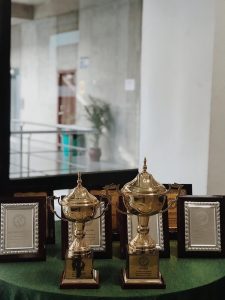
1740 hours: The teams are gearing up, and registration formalities are concluding fast. The hall is all filled up and the inauguration ceremony is soon to start.
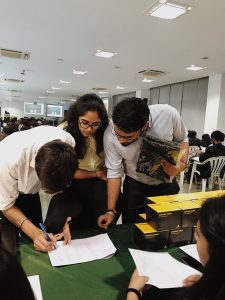
1815 hours: The inauguration ceremony is underway! We have Organizing Committee Members Shikhar Maniar, and Akanksha Singh who introduce the members on the dias- Dr. Bimal N. Patel, Director, GNLU; Dr. Girish R., Faculty Convener, GIMC 2019 Organising Committee, and Dr. Garima Goswami, Faculty Co-Convener, GIMC 2019 Organising Committee.
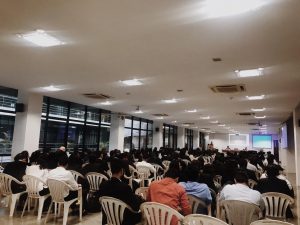
1818 hours: Prof. Dr. Bimal N. Patel, Director, GNLU begins his inaugural address by welcoming all participants to GNLU. He gives an insight into the foundation of GIMC, appreciating the work undertaken by both the present and past convenors in ensuring highest quality standards for GIMC. He also notices that the problem requires participants to develop an in depth understanding of international trade law. He also notes that participants will have access to well learned panelists, who will further guide the participants to improve their understanding of law.
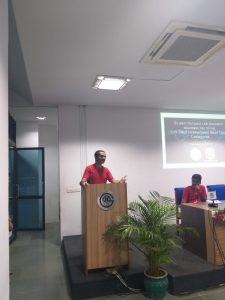
1820 hours: He also lays out how the moot problem is extremely relevant in terms of how it involves issues which will greatly impact global trade. He wishes the participants good luck, and also hopes that the moot serves as an opportunity to grow and learn, as well as interact with individuals from all around the world.
1824 hours: He speaks about the recent Conference on Sanctions which was held at GNLU in light of recent US sanctions on Iran. He advises the participants to think beyond the law as given, and develop an aptitude to resolve disputes, rather than restricting themselves to the law as exists. Rather, the participants must keep an attitude of dispute resolution by way of legal ingenuity and innovation.
1834 hours: He also speaks to the participants about how they must take this moot as an opportunity to present their arguments and ideas before an esteemed panel. He gives an idea on how a career in policy making can be built by participants.
1838 hours: Next, the Faculty Convener of GIMC, Dr. Girish R. announces the prizes of the competition. This surely catches the attention of the participants!
1840 hours: Further, he reassures the participants that highly competitive rounds will be conducted, and the judges will have both specialization and work experience in the field of international trade law. He also states that the moot problem is also drafted by an alumni with considerable experience with trade law, and a bench memorandum was also prepared by the drafter. He also assures them that the competition will be conducted fairly and as per the declared rules.
1845 hours: He gives the participants a background into GNLU. He urges participants to not limit their connection with GNLU to merely this moot, and to instead, associate with GNLU in other ways through exchange programmes, diploma courses and training programmes.
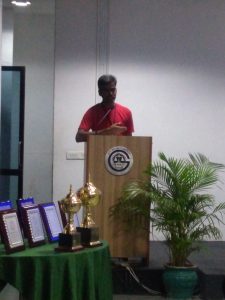
1848 hours: He also praises the efforts of the student conveners as well as coordinators in ensuring the success of the programme. He takes the responsibility of ensuring that all the problems of the participants are redressed and invites them for the inaugural as well as valedictory dinners.
1850 hours: The Faculty Co-Convenor, Mrs Garima Goswami also extends a warm welcome in a positive and refreshing speech to all the students. She notes that while the trophy here will only be lifted by only the best team, all teams have nothing to lose and will have the opportunity to learn as well as develop interpersonal bonds.
1857 hours: Next we have in store for the participants a training session on SCCOnline. The session is engaging and includes some handy tips on legal research which shall surely help the participants to fine tune and refine their legal research skills.
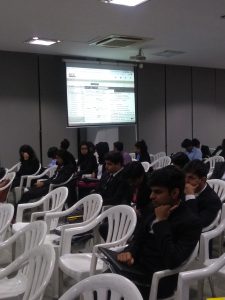
1919 hours: The participant’s orientation now begins! Logistics Coordinator, Smrithi Bhaskar gives out the rules and instructions regarding the conduct of the rounds. The participants listen attentively as this could make or break their chances here.
1930 hours: The inaugural ceremony draws to a close. Now, researchers are getting ready for the researchers test. This test will determine who gets the best researcher and the second best researcher awards.
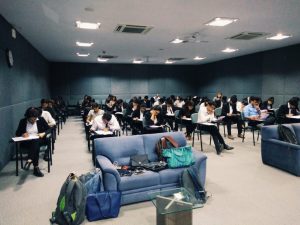
Preliminary Rounds- Day 1
0930 hours: The stage is set and the sun is shining, the atmosphere is perfect to witness some high quality mooting, as we begin with the first day of preliminary rounds, here at GIMC 2019!
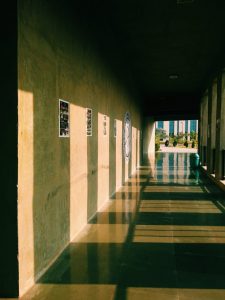
1015 hours: Teams do not waste a moment, as they know that preparation is what will get them that amazing trophy. As rounds begin, teams in the waiting room have last minute discussions on both law and strategy.
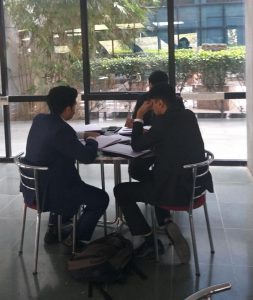
1030 hours: The preliminary rounds are underway! Teams are presenting the arguments they have been working extremely hard on for the first time before a panel of judges. Surely an exciting time to check their understanding and grip on the law.
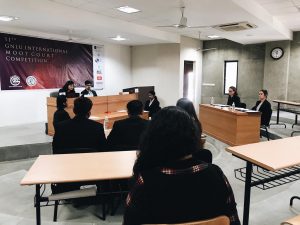
1125 hours: Making GIMC a success takes the efforts of many people put together. Do stay tuned to our Facebook page for a surprise, which shows our appreciation for the efforts of our OC members. As the preliminary rounds are underway now, teams are really seeing their arguments being put to the test.
1630 hours: Post lunch, the preliminary rounds are in full swing! Our conversations with the participants tell us that they seem to be enjoying the expansive campus of GNLU as well as the easy availability of facilities within the campus.
1930 hours: The rounds today are drawing to a close, and teams are beginning to make their way to dinner. What an exhilarating day of mooting it was!
Preliminary Rounds- Day 2
1030 hours: This WTO Panel is now in session! It is a new day and the one on one battles between teams continue. Teams seem to be pleased with the high quality of judging from what we found out, and are also liking the food here.
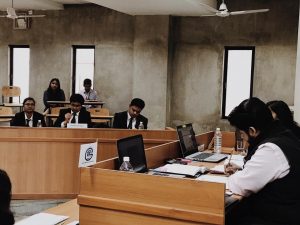
1400 hours: Lunch is almost done for the participants, and the preliminary rounds will soon continue. Some teams however, seem extremely confident and are already discussing strategies for quarters! Wow!
1500 hours: Who are the faces of GIMC 2019? Our amazing participants, obviously. The official photograph is clicked, and teams make their way back to their courtrooms.
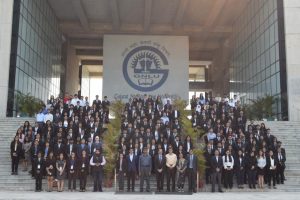
1900 hours: The preliminary rounds of GIMC 2019 have officially concluded. Teams are now anxiously waiting for the result, and so are we.
2110 hours: After the anxious waiting, the results for the preliminary rounds are finally in. Now, the top 8 teams must battle it out again tomorrow, in the quarters, followed by the semis. The stakes are getting higher!
Quarter-Finals
0900 hours: The courtroom set up is in full swing, and teams are ready on campus. Another day of great mooting is going to begin. We will post our top eight teams here soon. Stay tuned!
1130 hours: The quarter finals are underway, and there is palpable tension on the faces of participants as they await their turn to speak before the panel. The team codes in the quarter finals are:
Team 124
Team 128
Team 129
Team 152
Team 139
Team 149
Team 138
Team 160
1145 hours: The rounds continue on, and the teams put forward their best game. Today will determine their fate tomorrow, so this is no time for mistakes.
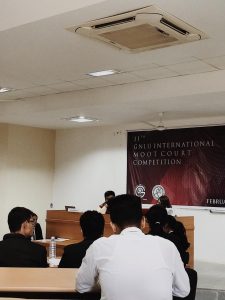
1500 hours: The results of the quarter finals are here! Teams have 30 minutes to prep up before the semi-finals start, and the top 4 teams go face to face.
Semi-Finals
1510 hours: As the teams prep, the Organizing Committee is busy setting up the courtroom. It is ready to welcome the top four. If you are here on campus, come and see these rounds.
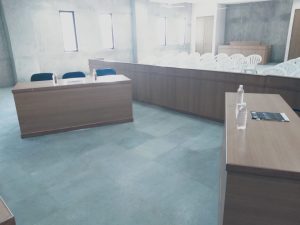
1525 hours: The teams are in the courtroom now. Last minute prep continues as they wait eagerly for the judges. Teams are discussing how to communicate with each other during the course of the rounds.
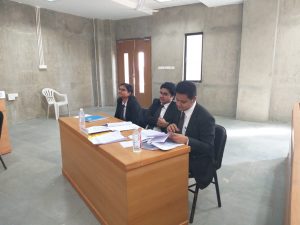
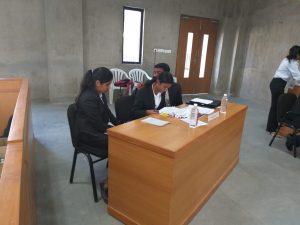
1526 hours: Our esteemed panelists are arriving. Teams eagerly watch on to see who will be judging them today. Our teams today are:
Team 124
Team 129
Team 138
Team 160
1530 hours: The first speaker for the Complainant begins her submissions by laying down her structure. She seems confident, and the judges listen intently.
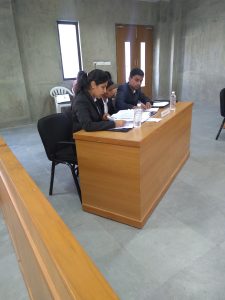
1532 hours: The panelist places his first question before the speaker. The speaker seems to have already anticipated this argument, and gives answers which seem to be well prepared. The judge continues questioning her, and she uses the facts of the moot problem to answer.
1535 hours: The speaker seems a little fazed as the judge keeps questioning her. She takes a moment to collect her calm and answers. The judge seems satisfied with the response.
1540 hours: The judge continues questioning the speaker, using a hypothetical situation to explain his question. The speaker seems to understand it correctly, and places her logic before the judge.
1545 hours: The speaker uses an authority to support her next argument and guides the panel to her compendium. The panel does not question her much on this point, and she moves to her next contention.
1548 hours: The Panelist doesn’t seem to convinced by Complainants argument. However, she has an answer ready, and uses this well versed answer to her favor. She runs out of time, and gets an extension of 45 seconds.
1552 hours: The second speaker of the Complainant begins her arguments. She is calm in her approach, and questions by the judges do not faze her, or make her deviate from her structure.
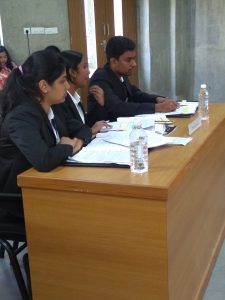
1554 hours: The judge asks the speaker a question to check her understanding. The speaker refers the compendium to substantiate her argument. The judge asks her to give a specific answer and she takes a moment to find this data.
1600 hours: The speaker uses some provisions, and the usage is questioned by the panel. However, the speaker disagrees with the panel, and uses an authority to answer the question. However, the panel does not seem convinced.
1605 hours: The speaker finishes her arguments before the allotted time. The panel now seems to be having some discussion. The panel decides to give the first speaker some more time to complete her arguments.
1608 hours: The time has elapsed for the complainant, and now the respondents begin with their submissions. The first speaker is questioned on an authority that he is using, and he answers but the panel is not convinced.
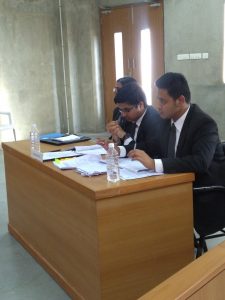
1615 hours: The speaker calmly continues his arguments despite the tricky questions placed before him by the panel. He seems to be prepared, and relies on various authorities while answering.
1622 hours: Facts are the key! The speaker states the facts which help him argue his contentions. The speaker seems to have a blend of both law and fact as he answers confidently. The wave of questions however continues.
1625 hours: As the speaker tries to wrap up, the panelist poses more questions. After answering the questions, the first speaker concludes, and now, the second speaker takes the stage.
1628 hours: The panelist asks the speaker to assume that the argument is not accepted, and asks him to argue on other grounds. This does not disappoint the speaker, and he continues to present his alternative arguments.
1633 hours: It seems to be a really long session of question and answers. The speaker is not able to put forth his contentions. The speaker realizes that his arguments are not being accepted and moves ahead to his next issue.
1638 hours: The speaker continues persuading the panel about his arguments. He directs the panel to his written submissions as he guides them through his next issue. The panel seems largely interested in this argument.
1645 hours: The panelist is coming up with situations to confuse the speaker. The speaker runs out of time, is given an extension. He is heavily using his compendium today, it seems to be a true life saver!
1646 hours: The time for arguments has ended, and now it is time for the rebuttals! The complainants raise their points. After a caution from the panel to limit themselves to only the points raised, the respondents answer the questions.
1652 hours: The replies are done and it is a wrap up for the first round of semi finals! The panel speaks to the participants and thank them for presenting their arguments. Now, the second round is soon to start.
1712 hours: The participants for the second round are here. It is time for another interesting round of argumentation. The judges are ready to begin.
1714 hours: The first speaker for the complainant begins her submissions. She outlines the structure, and explains the division of time, and starts off with her first issue.
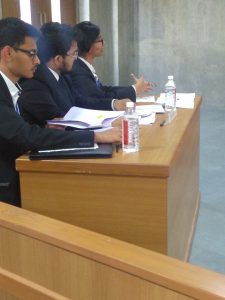
1715 hours: The panel asks the speaker whether a particular argument is necessary. The speaker responds by stating that such an argument has been raised by the respondents which is why it is being dealt with. The speaker is asked to not get into the contention.
1717 hours: The speaker argues impressively based on interpretations based on facts.The panel asks the speaker to clarify the issue she just argued. The speaker gets ample time to put forth her points without being questioned.
1721 hours: The speaker argues calmly and persuasively. She seems to know the facts on her fingertips, and is quick to answer a factual concern raised by the panel. She seems to be treading carefully, and continues trying to convince the panel.
1725 hours: The panel is not convinced but instead of allowing the speaker to move to her alternative arguments, the panel breaks her argument down to three parts, and questions her on each of them. She patiently answers, but the panelist is not convinced.
1731 hours: The speaker runs out of time, and had a whole issue remaining to address. She is given only one minute to summarize. She, however, is unable to complete, and the panelists tell her that they shall look at the arguments in the written submissions.
1732 hours: Now, it is time for the second speaker to begin his arguments. He is faced with a question which he does not clearly understand, and which has to be clarified by the panelist. The speaker keeps getting interrupted by the panelist with more and more questions.
1736 hours: The speaker changes his answer on a previous question as the panel questions him further. It seems like he understood the relevance of the panelists question now. As he clarifies, the panelists asks him to carry on, and he continues his argument.
1738 hours: The speaker uses provisions of the law, and the facts to explain his argument. The team also passes on some material to the judge to elucidate their point better. The speaker now moves to extremely fact specific arguments, and the panel allows him to complete. Now, he moves to his next issue.
1741 hours: For the next issue, the speaker relies on an authority, and urges the panel to refer to the compendium. He also passes some material to the judge and refers them to some relevant paragraphs. There seems to be an exchange of material happening between the team and the panel.
1748 hours: The panelist places a question before the speaker, and as the speaker seems confident with the answer, he is asked to move ahead.
1750 hours: With time quickly elapsing the speaker must now rush with his contentions. The time gets over just as the panel asks a question to the speaker. The panel asks the speaker to only answer the question asked. However, he is unable to complete his contentions.
1752 hours: The first speaker from the respondents begins her arguments. She lays out the framework of the arguments, and defines the issues that she will be dealing with.
1754 hours: The panelists ask the speaker to give some legal backing for a proposition that is made by her. She seems to be ready with the authorities and directs the panel to their compendium.
1756 hours: The panel does not seem happy with the approach taken by the respondent, and labels it as chicken-and-egg situation. The respondent continues to persuade the panel, and the panel asks the speaker to keep some confidence.
1800 hours: The arguments of the respondent are largely based on factual grounds, and she seems to be gaining confidence. The panelists also listen to her attentively. She is then faced with a question asking for legal backing for her argument.
1806 hours: The panelist asks the speaker for some conceptual clarifications. These questions seem to be difficult for the speaker, but she calmly makes a clarification which seems to convince the panel.
1810 hours: With the panelist bombarding the speaker with question she seems to be a little impatient. She completes her submissions abruptly as she runs out of time. The second speaker now begins her submissions, starting where the previous speaker had left off.
1814 hours: The panelist asks a factual question, and this is followed by a discussion on facts by the speaker. The researcher is quick to open up all the relevant pages of the moot problem. What team coordination!
1819 hours: The panelist finds it difficult to understand the logical correlation between the arguments, and the debate on facts continues. The panelist keeps directing the speaker to the facts, and attempts to understand the crux of the arguments raised by the respondent.
1824 hours: The respondents have heavily relied on the facts of the case to substantiate. An authority raised by the respondent is questioned by the panelist, as to its bindingness. The speaker is ready with a reply.
1826 hours: A hypothetical question is again placed before the speaker by the panel. The speaker replies, and the panel asks whether the speaker is conceding to a point. The speaker refuses, and continues with her arguments. The speaker is running out of time, and only gets 30 seconds to answer.
1829 hours: The respondent’s time elapses, and now rebuttals begin. The complainants point out the failure of the respondent in dealing with some crucial questions involved in the case. The rebuttals raised are extremely structured.
1832 hours: The respondents now answer the issues pointed out by the complainant. It is a challenge for them with the high number of rebuttals, and the limited time available to the respondents. As one speaker speaks, the other speaker and the researcher are quick to prepare answers for the other points raised.
1838 hours: The rebuttals draw to a close, bringing the semi final rounds today to an end. Now, participants must eagerly wait for the results, while the scoring team dives into action. Good luck to all the semi-finalists!
1940 hours: The participants are now being introduced to the World Trade Institute in Berne, our Academic Support Partner, by Ms. Corrine Karlaganis, who is the Outreach Associate for the World Trade Institute.
1950 hours: Next one of the semi finals judges, Ms. Wakako Oshima who is also an alumni of the World Trade Institute. She speaks about her experiences at the World Trade Institute, and the diversity of studying with 30 students from 27 countries and highly recommends the MILE Programme to the students.
1955 hours: Participants of the competition are now being awarded their participation certificates by Dr. R.K. Singh, Dean of Academic Affairs.
Finals
1500 hours: The final courtroom is set up, and we are ready to begin. Our panelists today are:
Ms. Anuradha RV
Partner, Clarus Law Associates
Mr. Santanu Mukherjee
Advocate & Head of Chambers, Ex Lege Chambers Advocates & Regulatory, Policy Advisors
Mr. V. Lakshmikumaran
Managing Partner, Lakshmikumaran & Sridharan Attorneys
Dr. James J. Nedumpara,
Professor and Head,
Centre for Trade and Investment Law,
Indian Institute of Foreign Trade
Mr. Andrea Schlaepfer,
Lecturer,
University of Bern
Our finalists are Christ University (Deemed to be), Bangalore and National University of Advanced Legal Studies, Kochi.
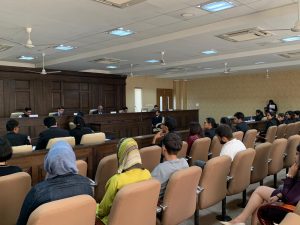
1508 hours: The first speaker from the complainant begins her arguments by laying down the time format and by putting down the structure of the arguments. She uses the case of US Softwood Lumber to show how a good need not be tangible.
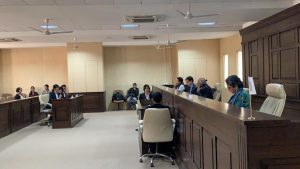
1511 hours: She continues by explaining how even a 25% minority stake in UMMC amounted as a stake which influenced the long term agreement, given the vulnerability of UMMC at the time. She is placed with a question from Panelist Mr. James Nedumpara, and seems confident in answering the questions.
1518 hours: The Speaker continues with her argument on the issue of whether a benefit has been conferred under the long-term supply arguments. She brings up the but-for test. Her contention is the supply of cobalt is not as dependent when being mined in the Conda mines because it is not the only mineral being mined there.
1520 hours: She guides the panel to Annexure 5 to show the changes in the price of cobalt. Her argument is that the price itself is unpredictable and keeps rising. Mr. V Lakshmikumaran does not seem convinced. The speaker clarifies that the benefit is not upon UMMC but on GRMM.
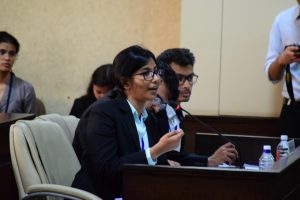
1523 hours: Ms. Anuradha RV points of the analysis of the speaker is completely ex post in nature. The speaker states that the agreement entered into the year 2027 according to the deemed market price. Further, she relies on an authority to show that the panel can look into ex post factors.
1525 hours: Next, the speaker moves to explain the existence of an export contingency. She states that nothing mandates that export contingency must be looked at from the perspective of the recipient. Dr. James Nedumpara asks for support from the SCM Agreement for this logic. He also draws the speaker’s attention to Article 2 of the Agreement relating to specificity.
1528 hours: Ms. Anuradha RV asks the speaker whether the argument is that Article 3 subsidies can be transnational, and Article 2 requires a territoriality requirement. As she is answering, she runs out of time, and her co-speaker now begins his submissions.
1530 hours: The speaker focuses on how IDB is a public body, he lays out that he will do this by focusing on the veto power within the IDB, and using the same to show meaningful control. Mr. James Nedumpara asks how an international body can be a public body, and fulfill the government requirement when it is based on an international agreement. Mr. V Lakshmikumaran also asks that as the veto is a negative power, would the same be a form of control. Ms. Anuradha RV also poses a question regarding how the IDB only remains the public body of Oxyonia, when other bodies are also involved.
1535 hours: Shantanu Mukherjee asks the Speaker about the functions of IDB and the role of institutions like IDB. The speaker answers, and also states that a negative veto power becomes a positive power when it is permanently conferred on a body.
1540 hours: The next issue relates to the benefits received by GRMM. The building of infrastructure as the part of the unrepaid loan is brought up, and how the same increases the share of GRMM is argued. This brings in a barrage of questions from the panel. Mr Santanu Mukherjee asks the counsel whether any effect on the market price can be necessarily considered a benefit. Santanu Mukherjee also asks the counsel whether the regulation which was brought in which effected the market was intended to do so.
1545 hours: Ms. Anuradha RV asks why Climatia did not pull out of IDB if it was such an unfair body for the benefit of Oxyonia only. He is also asked if other players would also benefit from the export duty waiver. He seems to convince the panel on this point.
1547 hours: The counsel proceeds with his answers to the panel’s questions – saying that the specific beneficiary is comparative, the specific benefit conferred on GRMM was higher than what market forces would allow without the imposition of the export duty.
1550 hours: The speaker proceeds to his next issue of income and price support, and uses the case of China-GOES. The counsel relies on the GATT Panel Report during the Uruguay conference and goes on to prove the requirements under the SCM: supplementary measures taken by the government, and a specific benefit conferred on some party due to this measure.
1553 hours: He begins with his argument on Article XVI of the GATT, and just as he begins, his time elapses. He is not given an extension, and he concludes his submissions.
1554 hours: The first speaker from the respondent begins her submissions. She argues that the government must have a control over the specific thing made available. Ms. Anuradha RV asks whether the actions of the government of Oxyonia amounted to a threat. The speaker stated that the acts of the government were owing to a commercial interest, as shareholders.
1558 hours: Mr. Santanu asks a question relating to the fact that Ensen Brothers who were majority shareholders in UMMC also had problems with the deal. The panelists seem satisfied with the response given.
1601 hours: The next argument is that the financial contribution does not confer a benefit to GRMM. She uses the the Canadian Civil Aircraft Case, and the better off test as was laid down in the case. She uses the benchmark of the prevailing market price to show that the agreement was entered into at the market price and so the same was not a benefit.
1603 hours: The speaker moves on to her contention that the 20-year supply agreement is not a prohibited subsidy within the meaning of SCM Agreement as the same is not export contingent. Ms. Anuradha RV asks the speaker for clarity on the argument.
1605 hours: The speaker uses the fact that a substitute for cobalt will be available soon to show that there is no benefit as UMMC may have to shut down operations as UMMC has the right to decide whether to mine or not. Mr. Santanu asks if this is a presumption, and the speaker answers in affirmative.
1606 hours: The second speaker begins her submissions by stating that the IBD is not a public body. What is required is an evaluation of the functions of the body at hand. She explains that the IBD has a corporate structure with shareholders and it cannot be said that the same exercises governmental functions.
1608 hours: The panelist asks whether the veto power of Oxyonia US Anti-Dumping and Countervailing Duties- China states that a delegation of authority must be done by way of a legal instrument and the existence of mere links with the government are insufficent, and no such delegation was made to Oxyonia to the IBD, which does not make it a public body.
1612 hours: Mr Lakshmikumaran poses a question to the panelist on why a loan waiver cannot be considered a subsidy. The Speaker draws an inference to the treatment of the waiver as an obligation vis-a-vis its treatment as a privilege. Ms Anuradha RV seeks a clarification as to how this differential treatment is of consequence to the analysis under the SCM Agreement.
1614 hours: Mr. Santanu asked what would happen if the privilege is not met, and what would happen if the unrepaid loan amount is not waived off, and if the same would then become an obligation instead of a privilege.
1620 hours: The speaker moves on to her next argument and just as she begins, she is faced with a question from Mr. V. Lakshmikumaran. Mr Lakshmikumaran points out how the actions of Oxyonia (Respondent) in imposing 50% export duties are discriminatory and invites the Speaker to refute that contention.
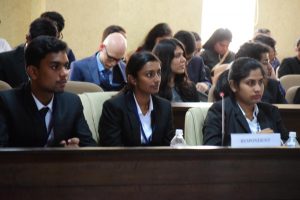
1624 hours: The argument of the speaker now is that price depression is caused by the agreement between GRMM and GreenO, and not by the export subsidies. Ms Anuradha RV asks whether or not the agreement is a result of the statement made by the Finance Minister.
1627 hours: The speaker asserts that the imposition of export duty amounts to a positive act on behalf of the government. The purpose of this to prevent domestic market distortion.
1628 hours: The speaker moves to her last argument and is allowed some extra time by the panel. The Speaker statesthat the words of the Minister of Finance are mere words of encouragement and cannot be read as market intervention on behalf of the government. She is allowed to proceed with her next argument due to paucity of time although the panel seems unconvinced with her answer. Next, she argues on how the private agreement between parties can be challenged as an anti-competitive agreement, but cannot be brought under the SCM agreement.
1630 hours: The Speaker seems to concede on her final argument, however the panel is apprehensive since they are of the opinion that this issue would have been their strongest argument. Mr V Lakshmikumaran gives her a lead, and urges her to argue this contention to their favour.
1635 hours: The rebuttals begin, with Mr. Lakshmikumaran asking the complainant to rebut the final argument raised by the respondent on the issues of territoriality. It is the contention of the Complainant that the only beneficiary is Green O. The panel asks the speaker whether they can lift the veil to find out the real beneficiary.
1640 hours: Ms. Anuradha RV asks the respondents a question pertaining to the locus of the financial contribution. The speaker relies on the US Anti-Dumping and the Countervailing Duties case to support his argument.
1642 hours: The reply to the rebuttals is completed, and now we all must wait for the final results!
Valedictory Ceremony
1717 hours: The closing ceremony for the 11th edition of GIMC is underway. The chief guest for the evening is Mr. Lakshmikumaran, Managing Partner, Lakshmikumaran & Sridharan and the guests of honor are the panelists for the final rounds of GIMC ’19.
1718 hours: The guests are honored by Dr. R.K. Singh, Dean, Academic Affairs GNLU.
1720 hours: Dr. R.K. Singh now delivers the welcome address. He notes that the success of a moot court competition is based on four factors: passionate and enthusiastic participants, the eminent experts who add credibility to this competition, the quality of the problem that is drafted, and the organizing committee. He notes that all of the four factors are present in GIMC, and these have helped GIMC maintain higher goals for itself.
1727 hours: Next, Mr. V Lakshmikumaran addresses the gathering. He speaks of the practice of law as a great opportunity which makes one richer. Earlier, this was considered to be the last resort, however, now it is the most preferred, competitive occupation with lots of rewards. With age, you mature in law, unlike other professions where one becomes useless with age. But a bald head or grey hair is welcome in law. Experience makes one better and better and salable in law.
1731 hours: He notes that the practice in law firms will make one earn lots of money, but the same will evaporate. He states that greatest politicians are lawyers, as lawyers are able to analyze and articulate things inside and outside the courtroom. This training makes one richer as a person, not the wealth one accumulates.
1736 hours: He also shares his own experiences and what makes a good lawyer. One must share knowledge and experience with one’s juniors, and one must not be scared of the juniors being better than themselves. The whole point of experience is to share it, and to make others grow.
1739 hours: Next, Mr James Nedumpara addresses the gathering. He states that GIMC is the best moot court competition that India has made. He expresses delight at the number of teams in the competition, and states that the same expresses the faith that persons have in the multilateral trading system.
1742 hours: Next, Mr. Andrea Schafer speaks to the students, and states that coming to such a moot court competition by itself is a challenge, and this competition is by itself allows to interact with other people, both within their teams and outside. It also gives an opportunity to create contacts with trade professionals and lawyers.
1746 hours: Ms. Anuradha RV next highlights how she was impressed by this year’s problem and the futuristic aspect associated with it. The arguments presented show creativity and ingenuity and love for trade law, which is the most intellectually challenging law, according to her.
1749 hours: Mr Santanu Mukherjee next advises all the participants to start learning, start writing for law journals, and do mooting, which teaches you advocacy as well as research. He also speaks about his background in the World Trade Institute.
1752 hours: The most awaited part of the ceremony is here. The winners are now announced. The winners of the competition are School of Law, Christ University! The runners-up are the National University of Advanced Legal Studies, Kochi.
2015 hours: Here is the detailed Prize List!
Winners – School of Law, Christ (Deemed to be University)
Runners Up – National University of Advanced Legal Studies (NUALS), Kochi
Best Written Submissions– The National University of Advanced Legal Studies (NUALS), Kochi
Second Best Written Submissions– National Law University, Odisha (NLUO)
Best Orator – Final Round– Bansal Karthik, School of Law Christ (Deemed to be University)
Best Orator –Preliminary Rounds- Prakhar Khandelwal , National Law Institute University (NLIU), Bhopal
Second Best Orator – Preliminary Rounds- Kartikey Bansal, National Law Institute University (NLIU), Bhopal
Best Researcher- Pravi Jain, National Law Institute University (NLIU), Bhopal
Second Best Researcher- Sarika Bharti, National Law University, Odisha
Semi-Finalists – Rajiv Gandhi National University of Law
NMIMS Kirit P. Mehta School of Law
Quarter-Finalists– ILS Law College, Pune
Maharashtra National Law University, Mumbai (MNLU)
Institute of Law, Nirma University, Southampton University.
With this, the live blogging for GIMC ’19 signs off. See you next year!


